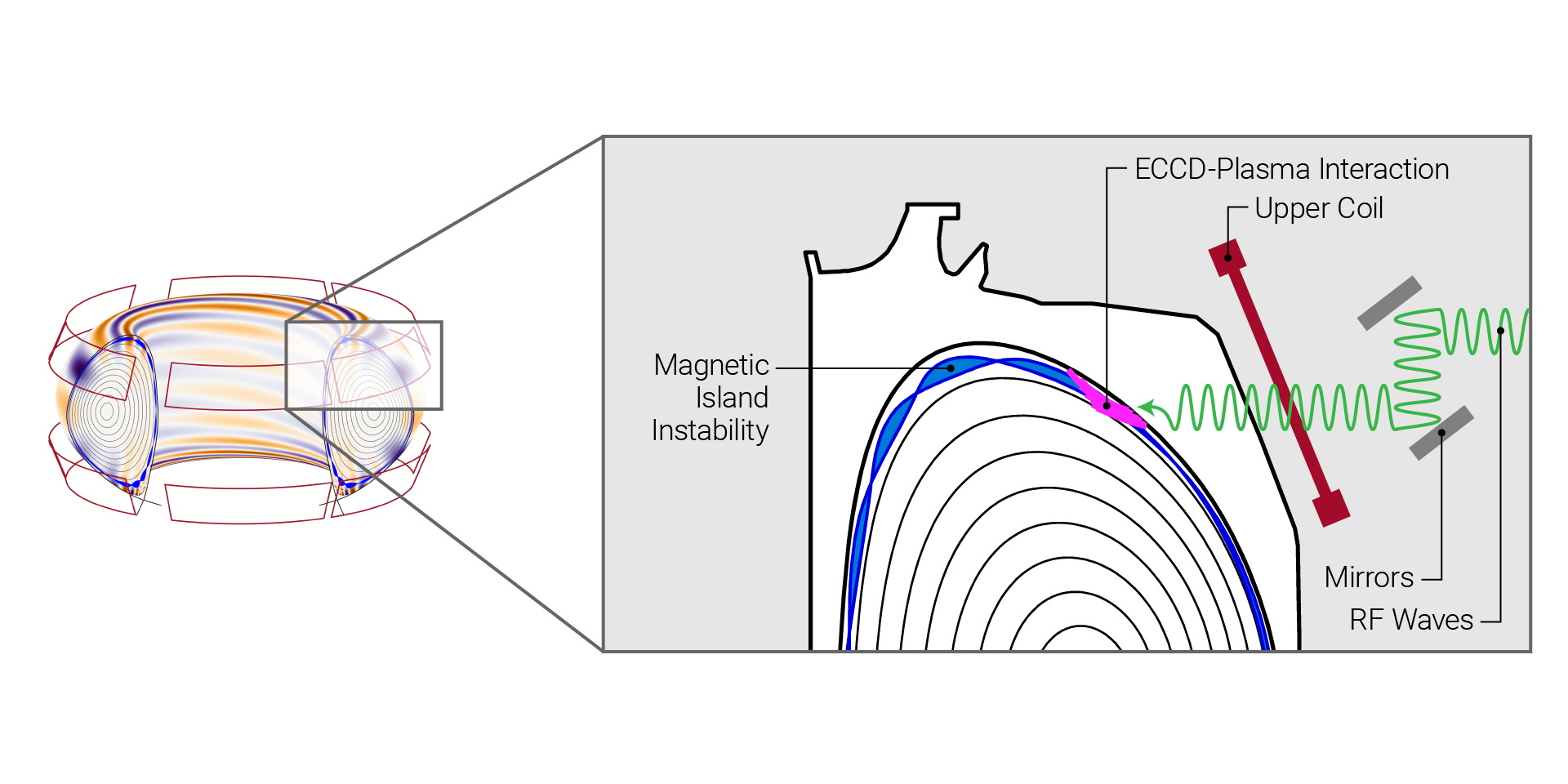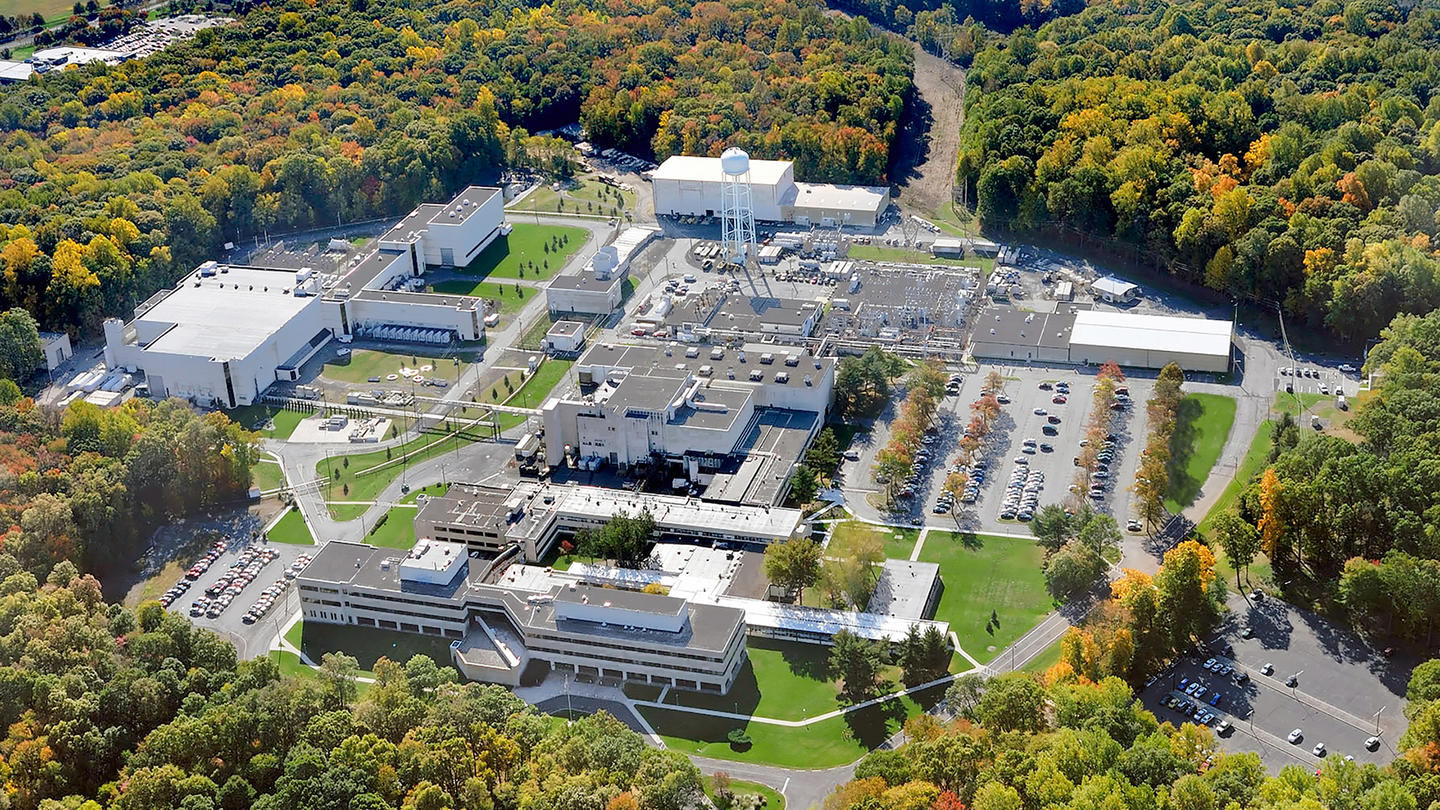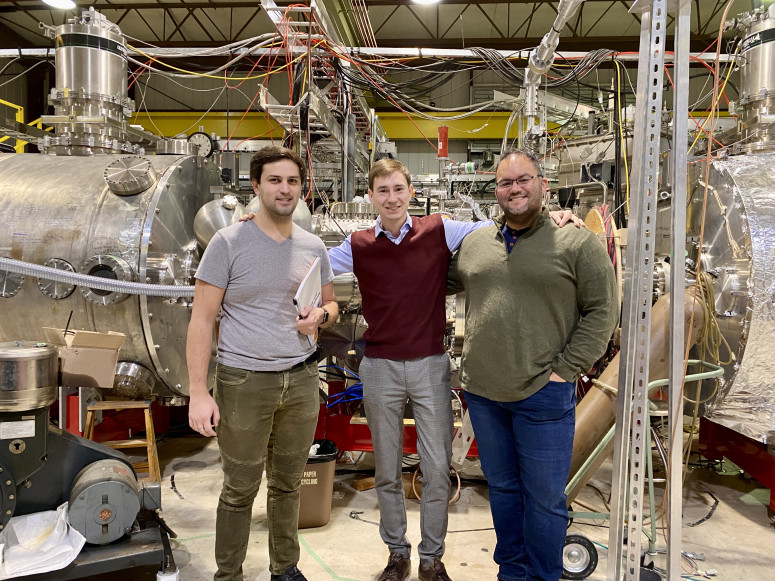A plastic pellet replica alongside a dime and the tool that cuts each pellet from a solid hydrogen filament. (Photo: Larry Baylor/ORNL)
In May, the Wendelstein 7-X stellarator in Greifswald, Germany, concluded an experimental campaign by sustaining a plasma with a high triple product for 43 seconds. The machine far surpassed its own previous performance with a value that the Max Planck Institute for Plasma Physics (IPP) says “exceeds previous tokamak records for long plasma durations”—in part because of a fuel pellet injection system developed by researchers at Oak Ridge National Laboratory.
Watch ORNL’s video of that fuel pellet injection system—in use since September 2024—as it extrudes a column of frozen hydrogen and then cuts individual 3.2-millimeter-long pellets. The process, which takes just half a millisecond, was captured in slow motion by ORNL engineer Steve Meitner.
An artist’s interpretation of the inside of a fusion vessel, where some of the inner surfaces are directly exposed to the plasma. Some regions lie in the “magnetic shadow” of other components and are therefore magnetically shielded from the intense heat of the plasma. (Image: Kyle Palmer/PPPL Communications Department)
Image: Kyle Palmer and Michael Livingston/PPPL Communications Department
The image on the left shows the tokamak and 3D magnetic perturbation generated by 3D coils, with the purple-blue hues representing lower amplitude perturbations and the red representing higher amplitude perturbations. The image on the right is a closer view showing the top half of the tokamak and plasma. The coils are used to generate the magnetic field perturbations that produce the islands (blue). Another coil can also be found on the bottom of the machine. The injection system for the ECCD microwaves is depicted on top (red). These can be used to adjust the width of the islands. (Image: Qiming Hu / PPPL)
The combination of two previously known methods for managing plasma conditions can result in enhanced control of plasma in a fusion reactor, according to a simulation performed by researchers at the Department of Energy’s Princeton Plasma Physics Laboratory.
The Princeton Plasma Physics Laboratory. (Photo: PPPL)
A team of engineers, physicists, and data scientists from Princeton University and the Princeton Plasma Physics Laboratory (PPPL) have used artificial intelligence (AI) to predict—and then avoid—the formation of a specific type of plasma instability in magnetic confinement fusion tokamaks. The researchers built and trained a model using past experimental data from operations at the DIII-D National Fusion Facility in San Diego, Calif., before proving through real-time experiments that their model could forecast so-called tearing mode instabilities up to 300 milliseconds in advance—enough time for an AI controller to adjust operating parameters and avoid a tear in the plasma that could potentially end the fusion reaction.
From left, engineer Jeremiah Kirch, postdoctoral researcher Mykola Ialovega, and assistant scientist Marcos Xavier Navarro-Gonzalez pose in front of the WHAM device at UW-Madison. (Photo: Mykola Ialovega)
A new type of cold spray coating, made from the metal tantalum and applied to the plasma-facing steel walls of fusion reactors, could lead to efficient, compact fusion reactors that are easy to repair and maintain, according to a study recently published in the journal Physica Scripta. The study was led by scientists and engineers at the University of Wisconsin–Madison and involved researchers from South Korea, France, and Germany.
A side-by-side comparison of a standard plasma configuration (at left) and the plasma created during the negative triangularity campaign at DIII-D, which was made possible by the installation of a temporary divertor region. (Image: General Atomics)
The DIII-D National Fusion Facility in San Diego, Calif., has completed a monthlong research campaign using a negative triangularity plasma configuration inside its fusion tokamak and produced initial data that “appear very encouraging,” according to an April 24 news release from General Atomics (GA), which operates the Office of Science user facility on behalf of the Department of Energy. Full experimental results on “the highest-powered negative triangularity experiments in the history of the U.S. fusion research program” are expected this summer, according to GA.
The UKAEA will provide novel fusion materials to be irradiated in ORNL’s HFIR facility over the next four years. Pictured (from left) are Kathy McCarthy, director of the U.S. ITER Project; Jeremy Busby, ORNL’s associate lab director for fusion and fission energy and science; Mickey Wade, ONRL Fusion Energy Division director; Ian Chapman, chief executive officer of the UKAEA; Cynthia Jenks, ORNL’s associate lab director for physical sciences; and Yutai Kato, ORNL Materials Science and Technology Division interim director.
The Department of Energy’s Oak Ridge National Laboratory (ORNL) and the U.K. Atomic Energy Authority (UKAEA) have formed a strategic research partnership to investigate how different types of materials behave under the influence of high-energy neutron sources. The five-year partnership was announced by ORNL and by the UKAEA on March 13.
The first sector of the ITER vacuum vessel was placed in the assembly pit in May. Here, a technician positions targets on the surface of the component to be used in laser metrology. (Photo: ITER Organization)
Delivery of electricity from fusion is considered by the National Academies of Engineering to be one of the grand challenges of the 21st century. The tremendous progress in fusion science and technology is underpinning efforts by nuclear experts and advocates to tackle many of the key challenges that must be addressed to construct a fusion pilot plant and make practical fusion possible.
Invisible infrared light from the 200-trillion-watt Trident Laser at Los Alamos National Laboratory interacts with a 1-micrometer thick foil target (in the center of the photo) to generate a high-energy-density plasma. (Photo: Joseph Cowan and Kirk Flippo, LANL)
The Department of Energy’s Office of Science (DOE-SC) and the National Nuclear Security Administration (NNSA) on July 27 announced $9.35 million for 21 research projects in high-energy-density laboratory plasmas. High-energy-density (HED) plasma research, originally developed to support the U.S. nuclear weapons program, has applications in astrophysics, fusion power plant development, medicine, nuclear and particle physics, and radioisotope production.
Plasma in MAST. (Photo: UKAEA/EUROfusion)
As governments around the world cooperate on the ITER tokamak and, in parallel, race each other and private companies to develop commercial fusion power concepts, it seems that “game-changing” developments are proclaimed almost weekly. Recently, the United Kingdom and China announced new fusion program results.












